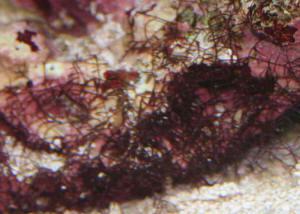- Joined
- Aug 8, 2019
- Messages
- 179
- Reaction score
- 133
I'm having issues with a dark reddish hair/turf algae kind of thing growing on one of my main base rocks in my tank.
It's a dark red/brown, seems to be individual hair-like strands, and it's spreading over the rock. I can manually yank it out but it tends to leave runners behind and grows back pretty quick. My bullet Goby likes to dump the sand he's sifted on this spot so the algae ends up with a lot of sand in and around its roots which is helping it to grow and spread.
Tank is a 20 Gal Waterbox AIO. No skimmer (too hard to maintain salinity in a small tank with an ATO and a skimmer)
I've moved over to a Santa Monica Algae Scrubber in the back chamber, but the algae doesn't grow much at all in the scrubber yet. Been about a month and a half since I installed that. Previously just grew Chaeto in the back. Some filter floss changed every few days, a bag of Chemipure blue.
I use an AWC that does daily 1-2% water changes, & an ATO for top ups.
I feed 1-2 cubes frozen every second day (give or take)
It's a mixed LPS reef (zoa's, Gonio's, Alveo, a small torch and hammer, a Blasto and an Elegance) with a Maxima clam and a BTA.
I'm a little overstocked with a pair of clowns, a small Rainford Goby, Bullet Goby and a Lawnmower Blennie, pair of coral banded shrimp, a heap of zombie snails, a few Ceriths, Turbos and Trochus and a single yellow leg Hermit. (I struggle to find hermits that don't feast on the snails). But the tank is fairly stable, everything is growing pretty well and seems happy.
The Lawnmower Blennie happily eats frozen food as well as dried nori, but doesn't pay any attention to the nuisance algae.
I don't get an insurmountable amount of algae on the glass (scrape it down once or twice a week)
Nitrates and phosphates are a little high at 20 and 0.5 respectively (Measured with Hannah Checkers) The Algae Scrubber seems to be getting off to a slow start and I think that's caused my nutrients to drift a little high, but the Algae's been around since well before that.
1) What type of algae is this?
2) Whats the best way to get rid of it?
The Algae Scrubber hasn't been doing much yet so I can pull that out for a bit and use chemical treatments (as long as it's safe for everything else in the tank).
I'm also happy to try biological methods but I'm in Aust so available CUC options are a little limited.
Appreciate any advice






It's a dark red/brown, seems to be individual hair-like strands, and it's spreading over the rock. I can manually yank it out but it tends to leave runners behind and grows back pretty quick. My bullet Goby likes to dump the sand he's sifted on this spot so the algae ends up with a lot of sand in and around its roots which is helping it to grow and spread.
Tank is a 20 Gal Waterbox AIO. No skimmer (too hard to maintain salinity in a small tank with an ATO and a skimmer)
I've moved over to a Santa Monica Algae Scrubber in the back chamber, but the algae doesn't grow much at all in the scrubber yet. Been about a month and a half since I installed that. Previously just grew Chaeto in the back. Some filter floss changed every few days, a bag of Chemipure blue.
I use an AWC that does daily 1-2% water changes, & an ATO for top ups.
I feed 1-2 cubes frozen every second day (give or take)
It's a mixed LPS reef (zoa's, Gonio's, Alveo, a small torch and hammer, a Blasto and an Elegance) with a Maxima clam and a BTA.
I'm a little overstocked with a pair of clowns, a small Rainford Goby, Bullet Goby and a Lawnmower Blennie, pair of coral banded shrimp, a heap of zombie snails, a few Ceriths, Turbos and Trochus and a single yellow leg Hermit. (I struggle to find hermits that don't feast on the snails). But the tank is fairly stable, everything is growing pretty well and seems happy.
The Lawnmower Blennie happily eats frozen food as well as dried nori, but doesn't pay any attention to the nuisance algae.
I don't get an insurmountable amount of algae on the glass (scrape it down once or twice a week)
Nitrates and phosphates are a little high at 20 and 0.5 respectively (Measured with Hannah Checkers) The Algae Scrubber seems to be getting off to a slow start and I think that's caused my nutrients to drift a little high, but the Algae's been around since well before that.
1) What type of algae is this?
2) Whats the best way to get rid of it?
The Algae Scrubber hasn't been doing much yet so I can pull that out for a bit and use chemical treatments (as long as it's safe for everything else in the tank).
I'm also happy to try biological methods but I'm in Aust so available CUC options are a little limited.
Appreciate any advice















